A Compact MIMO Antenna Based on Modal Analysis for 5G Wireless Applications
Abstract
:1. Introduction
- (a)
- Design of a non-uniform-shape and -spacing dual-element dipole array at 28 GHz.
- (b)
- Expansion of the dipole array to a three-element MIMO antenna to enhance channel capacity.
- (c)
- Enhancement of the isolation in a compact MIMO antenna with the design of a metasurface structure.
2. Antenna Design
2.1. Single-Element Dipole Antenna
2.2. Three-Element MIMO Antenna
3. Metasurface Structure
Unit Cell
4. MIMO Antenna with Metasurface
4.1. Impact on Antenna Performance with Change in Number and Location of Metasurface Unit Cells
4.2. Impact on Antenna Performance with Increase in Inter-element Spacing
5. Results and Discussion
5.1. |S-parameter| and Radiation Pattern
5.2. Diversity Performance
6. Comparative Analysis
7. Conclusions
Author Contributions
Funding
Data Availability Statement
Conflicts of Interest
References
- Hong, W.; Jiang, Z.H.; Yu, C.; Hou, D.; Wang, H.; Guo, C.; Hu, Y.; Kuai, L.; Yu, Y.; Jiang, Z.; et al. The Role of Millimeter-Wave Technologies in 5G/6G Wireless Communications. IEEE J. Microw. 2021, 1, 101–122. [Google Scholar] [CrossRef]
- He, R.; Schneider, C.; Ai, B.; Wang, G.; Zhong, Z.; Dupleich, D.A.; Thomae, R.S.; Boban, M.; Luo, J.; Zhang, Y. Propagation Channels of 5G Millimeter-Wave Vehicle-to-Vehicle Communications: Recent Advances and Future Challenges. IEEE Veh. Technol. Mag. 2020, 15, 16–26. [Google Scholar] [CrossRef]
- Mehrotra, P.; Chatterjee, B.; Sen, S. EM-Wave Biosensors: A Review of RF, Microwave, Mm-Wave and Optical Sensing. Sensors 2019, 19, 1013. [Google Scholar] [CrossRef]
- Sanayei, S.; Nosratinia, A. Antenna Selection in MIMO Systems. IEEE Commun. Mag. 2004, 42, 68–73. [Google Scholar] [CrossRef]
- Shariff, B.G.P.; Mane, P.R.; Kumar, P.; Ali, T.; Nabi Alsath, M.G. Planar MIMO Antenna for mmWave Applications: Evolution, Present Status & Future Scope. Heliyon 2023, 9, e13362. [Google Scholar] [CrossRef]
- Hussain, N.; Kim, N. Integrated Microwave and Mm-Wave MIMO Antenna Module With 360° Pattern Diversity for 5G Internet of Things. IEEE Internet Things J. 2022, 9, 24777–24789. [Google Scholar] [CrossRef]
- Aghoutane, B.; Das, S.; El Ghzaoui, M.; Madhav, B.T.P.; El Faylali, H. A Novel Dual Band High Gain 4-Port Millimeter Wave MIMO Antenna Array for 28/37 GHz 5G Applications. AEU Int. J. Electron. Commun. 2022, 145, 154071. [Google Scholar] [CrossRef]
- Usman, M.; Kobal, E.; Nasir, J.; Zhu, Y.; Yu, C.; Zhu, A. Compact SIW Fed Dual-Port Single Element Annular Slot MIMO Antenna for 5G mmWave Applications. IEEE Access 2021, 9, 91995–92002. [Google Scholar] [CrossRef]
- Zhang, Y.; Deng, J.-Y.; Sun, D.; Yin, J.-Y.; Guo, L.-X. Compact Slow-Wave SIW H-Plane Horn Antenna with Increased Gain for Vehicular Millimeter Wave Communication. IEEE Trans. Veh. Technol. 2021, 70, 7289–7293. [Google Scholar] [CrossRef]
- Zhu, Y.; Xu, H.; Deng, C. Single-Layer Dual-Polarized End-Fire Phased Array Antenna for 5G Mm-Wave Mobile Terminals. Antennas Wirel. Propag. Lett. 2024. early access. [Google Scholar] [CrossRef]
- Dai, X.; Li, A.; Luk, K.M. A Wideband Compact Magnetoelectric Dipole Antenna Fed by SICL for Millimeter Wave Applications. IEEE Trans. Antennas Propag. 2021, 69, 5278–5285. [Google Scholar] [CrossRef]
- Xiang, L.; Wu, F.; Yu, C.; Jiang, Z.H.; Yao, Y.; Hong, W. A Wideband Circularly Polarized Magneto-Electric Dipole Antenna Array for Millimeter-Wave Applications. IEEE Trans. Antennas Propag. 2022, 70, 3876–3881. [Google Scholar] [CrossRef]
- Liu, X.; Zhang, W.; Hao, D.; Liu, Y. Differential-Fed Magneto-Electric Dipole Antenna with Integrated Balun Based on Ball Grid Array Packaging. IEEE Trans. Compon. Packag. Manuf. Technol. 2022, 12, 981–987. [Google Scholar] [CrossRef]
- Wu, J.; Zhao, Z.; Nie, Z.-P.; Liu, Q.H. A compact printed dipole antenna for wideband wireless applications. Prog. Electromagn. Res. C 2014, 50, 95–102. [Google Scholar] [CrossRef]
- Ta, S.X.; Choo, H.; Park, I. Broadband Printed-Dipole Antenna and Its Arrays for 5G Applications. Antennas Wirel. Propag. Lett. 2017, 16, 2183–2186. [Google Scholar] [CrossRef]
- Wang, H.; Park, I. Characteristics of the Angled Printed Dipole Array Antenna with Different Numbers of Dipole Elements. J. Electromagn. Eng. Sci. 2020, 20, 183–189. [Google Scholar] [CrossRef]
- Puri, V.; Singh, H.S. Design of an Isolation Improved MIMO Antenna Using Metasurface Based Absorber for Wireless Applications. Optik 2022, 259, 168963. [Google Scholar] [CrossRef]
- Chowdhury, A.; Ranjan, P. SRR and DGS-Based Highly Isolated Four-Port MIMO Antenna for Mid-5G Band and High-5G Band. MAPAN 2023, 39, 321–336. [Google Scholar] [CrossRef]
- Hussain, M.; Awan, W.A.; Ali, E.M.; Alzaidi, M.S.; Alsharef, M.; Elkamchouchi, D.H.; Alzahrani, A.; Fathy Abo Sree, M. Isolation Improvement of Parasitic Element-Loaded Dual-Band MIMO Antenna for Mm-Wave Applications. Micromachines 2022, 13, 1918. [Google Scholar] [CrossRef]
- Desai, A.; Bui, C.D.; Patel, J.; Upadhyaya, T.; Byun, G.; Nguyen, T.K. Compact Wideband Four Element Optically Transparent MIMO Antenna for Mm-Wave 5G Applications. IEEE Access 2020, 8, 194206–194217. [Google Scholar] [CrossRef]
- Hamlbar Gerami, H.; Kazemi, R.; Fathy, A.E. Development of a Metasurface-Based Slot Antenna for 5G MIMO Applications with Minimized Cross-Polarization and Stable Radiation Patterns through Mode Manipulation. Sci. Rep. 2024, 14, 8016. [Google Scholar] [CrossRef]
- Shih, T.-Y.; Behdad, N. Bandwidth Enhancement of Platform-Mounted HF Antennas Using the Characteristic Mode Theory. IEEE Trans. Antennas Propag. 2016, 64, 2648–2659. [Google Scholar] [CrossRef]
- Yee, A.; Garbacz, R. Self- and Mutual-Admittances of Wire Antennas in Terms of Characteristic Modes. IEEE Trans. Antennas Propag. 1973, 21, 868–871. [Google Scholar] [CrossRef]
- Harrington, R.; Mautz, J. Theory of Characteristic Modes for Conducting Bodies. IEEE Trans. Antennas Propag. 1971, 19, 622–628. [Google Scholar] [CrossRef]
- Wu, Q.; Su, W.; Li, Z.; Su, D. Reduction in Out-of-Band Antenna Coupling Using Characteristic Mode Analysis. IEEE Trans. Antennas Propag. 2016, 64, 2732–2742. [Google Scholar] [CrossRef]
- Zeng, J.; Liang, X.; He, L.; Guan, F.; Lin, F.H.; Zi, J. Single-Fed Triple-Mode Wideband Circularly Polarized Microstrip Antennas Using Characteristic Mode Analysis. IEEE Trans. Antennas Propag. 2022, 70, 846–855. [Google Scholar] [CrossRef]
- Elias, B.B.Q.; Soh, P.J.; Al-Hadi, A.A.; Akkaraekthalin, P.; Vandenbosch, G.A.E. A Review of Antenna Analysis Using Characteristic Modes. IEEE Access 2021, 9, 98833–98862. [Google Scholar] [CrossRef]
- Shariff, B.G.P.; Ali, T.; Mane, P.R.; Alsath, M.G.N.; Kumar, P.; Pathan, S.; Kishk, A.A.; Khan, T. Design and Measurement of a Compact Millimeter Wave Highly Flexible MIMO Antenna Loaded with Metamaterial Reflective Surface for Wearable Applications. IEEE Access 2024, 12, 30066–30084. [Google Scholar] [CrossRef]
- SMA Connector. Available online: https://www.belfuse.com/resources/catalogs/cinchconnectivitysolutions/johnson/ca-ccs-john-mmwave-catalog.pdf (accessed on 1 February 2024).
- Khalid, M.; Iffat Naqvi, S.; Hussain, N.; Rahman, M.; Fawad; Mirjavadi, S.S.; Khan, M.J.; Amin, Y. 4-Port MIMO Antenna with Defected Ground Structure for 5G Millimeter Wave Applications. Electronics 2020, 9, 71. [Google Scholar] [CrossRef]
- Khan, J.; Ullah, S.; Ali, U.; Tahir, F.A.; Peter, I.; Matekovits, L. Design of a Millimeter-Wave MIMO Antenna Array for 5G Communication Terminals. Sensors 2022, 22, 2768. [Google Scholar] [CrossRef] [PubMed]
- Tariq, S.; Naqvi, S.I.; Hussain, N.; Amin, Y. A Metasurface-Based MIMO Antenna for 5G Millimeter-Wave Applications. IEEE Access 2021, 9, 51805–51817. [Google Scholar] [CrossRef]
- Abbas, M.A.; Allam, A.; Gaafar, A.; Elhennawy, H.M.; Sree, M.F.A. Compact UWB MIMO Antenna for 5G Millimeter-Wave Applications. Sensors 2023, 23, 2702. [Google Scholar] [CrossRef]
- Singh, A.K.; Dwivedi, A.K.; Jha, C.; Singh, S.; Singh, V.; Yadav, R.S. A Compact MIMO Antenna for 5G NR Frequency Bands N257/N258/N261 under Millimeter-Wave Communication. IETE J. Res. 2023, 69, 8561–8573. [Google Scholar] [CrossRef]
- Modak, S.; Lokam, A.; Farooq, U. Characteristic Mode Based Self Isolated MIMO Antenna Design for Millimeter Wave 5G Communications. AEU Int. J. Electron. Commun. 2024, 178, 155257. [Google Scholar] [CrossRef]
- Munir, M.E.; Kiani, S.H.; Savci, H.S.; Marey, M.; Khan, J.; Mostafa, H.; Parchin, N.O. A Four Element Mm-Wave MIMO Antenna System with Wide-Band and High Isolation Characteristics for 5G Applications. Micromachines 2023, 14, 776. [Google Scholar] [CrossRef]
- Islam, T.; Alsunaydih, F.N.; Alsaleem, F.; Alhassoon, K. Analyzing the Performance of Millimeter Wave MIMO Antenna under Different Orientation of Unit Element. Micromachines 2023, 14, 1975. [Google Scholar] [CrossRef]
- Aboualalaa, M.; Mansour, I. Dual-Band End-Fire Four-Element MIMO Antenna Array Using Split-Ring Structure for Mm-Wave 5G Applications. IEEE Access 2023, 11, 57383–57390. [Google Scholar] [CrossRef]
- Irshad Khan, M.; Liu, S.; Kabir Khan, M.; Ur Rahman, S. Eight Elements Mm-Wave MIMO Antenna for Anti-Collision Radar Sensing Application with Novel Hybrid Techniques. AEU Int. J. Electron. Commun. 2023, 167, 154687. [Google Scholar] [CrossRef]
- Farooq, U.; Lokam, A. A Compact 26/39 GHz Millimeter Wave MIMO Antenna Design for 5G IoT Applications. J. Infrared Millim. Terahertz Waves 2023, 44, 333–345. [Google Scholar] [CrossRef]

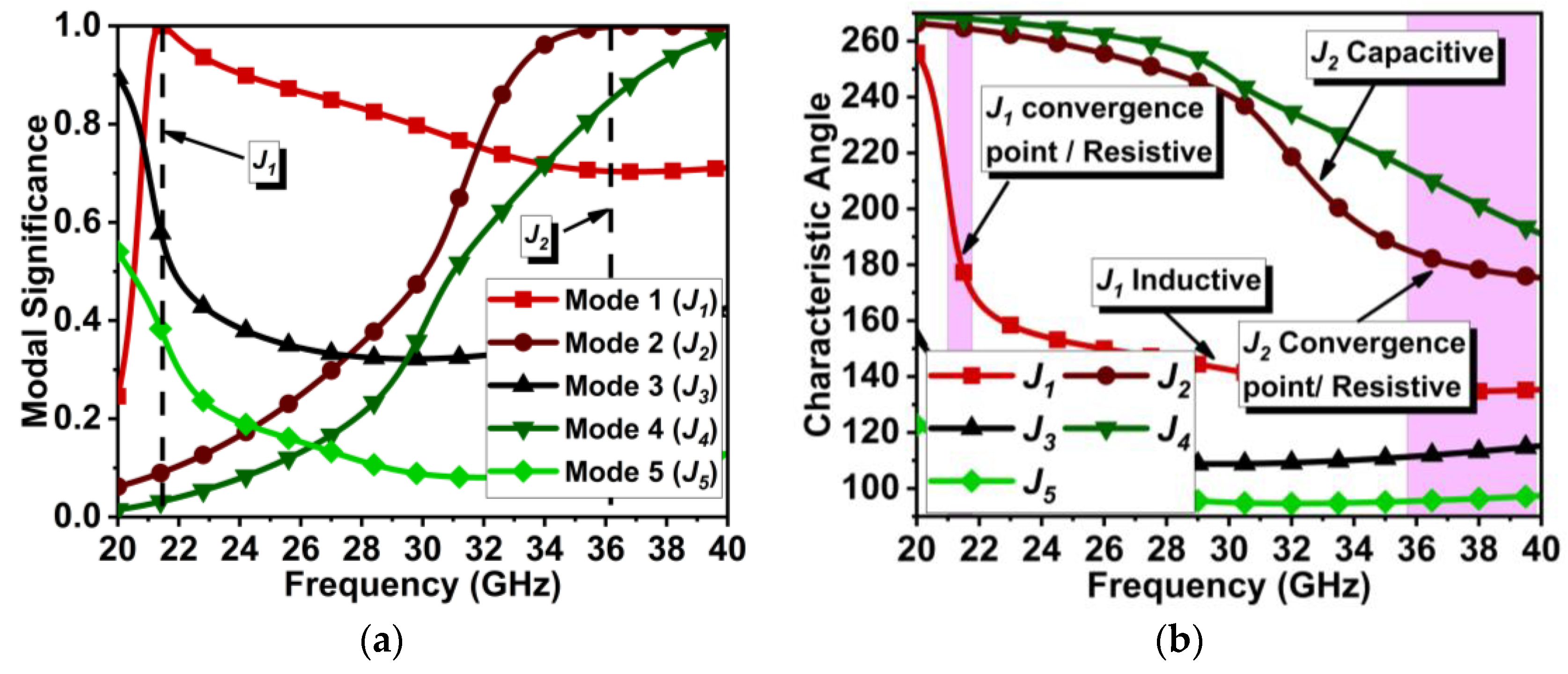
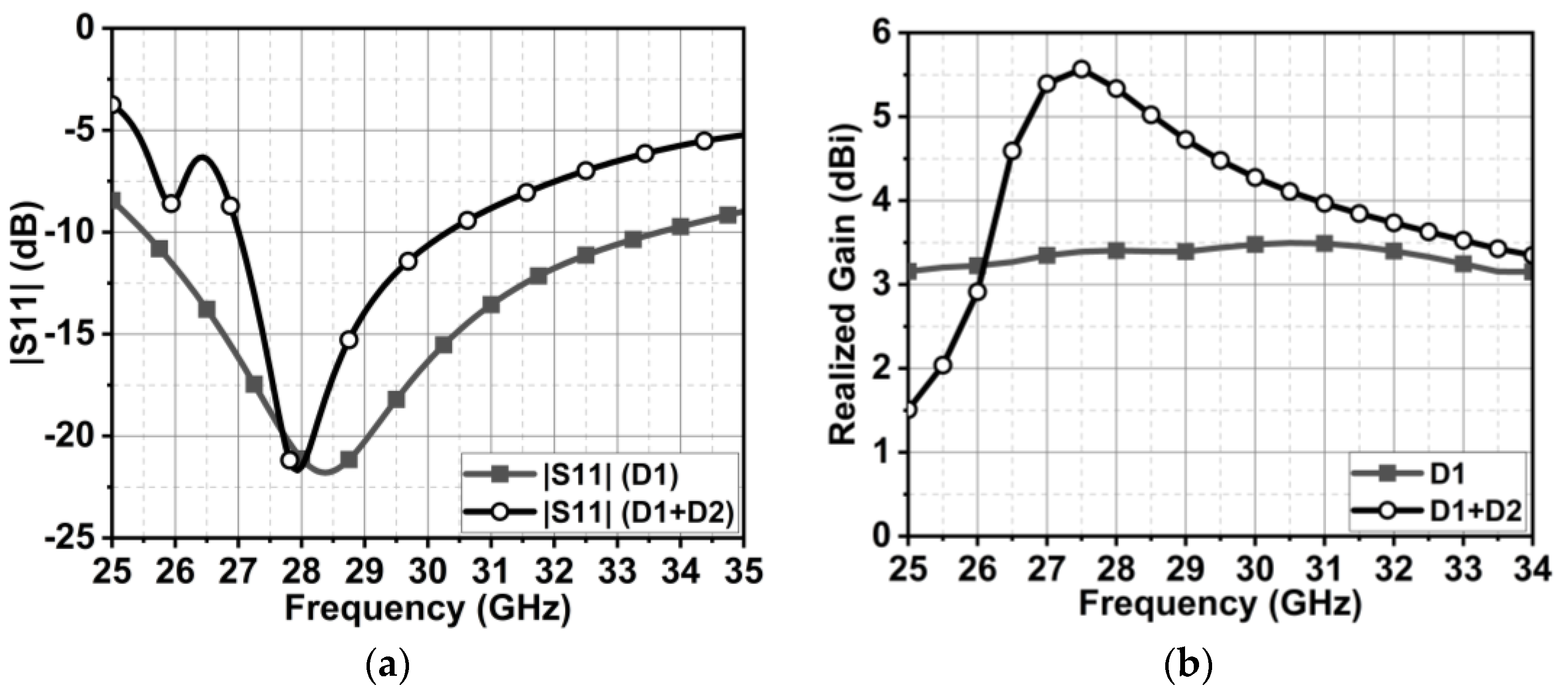


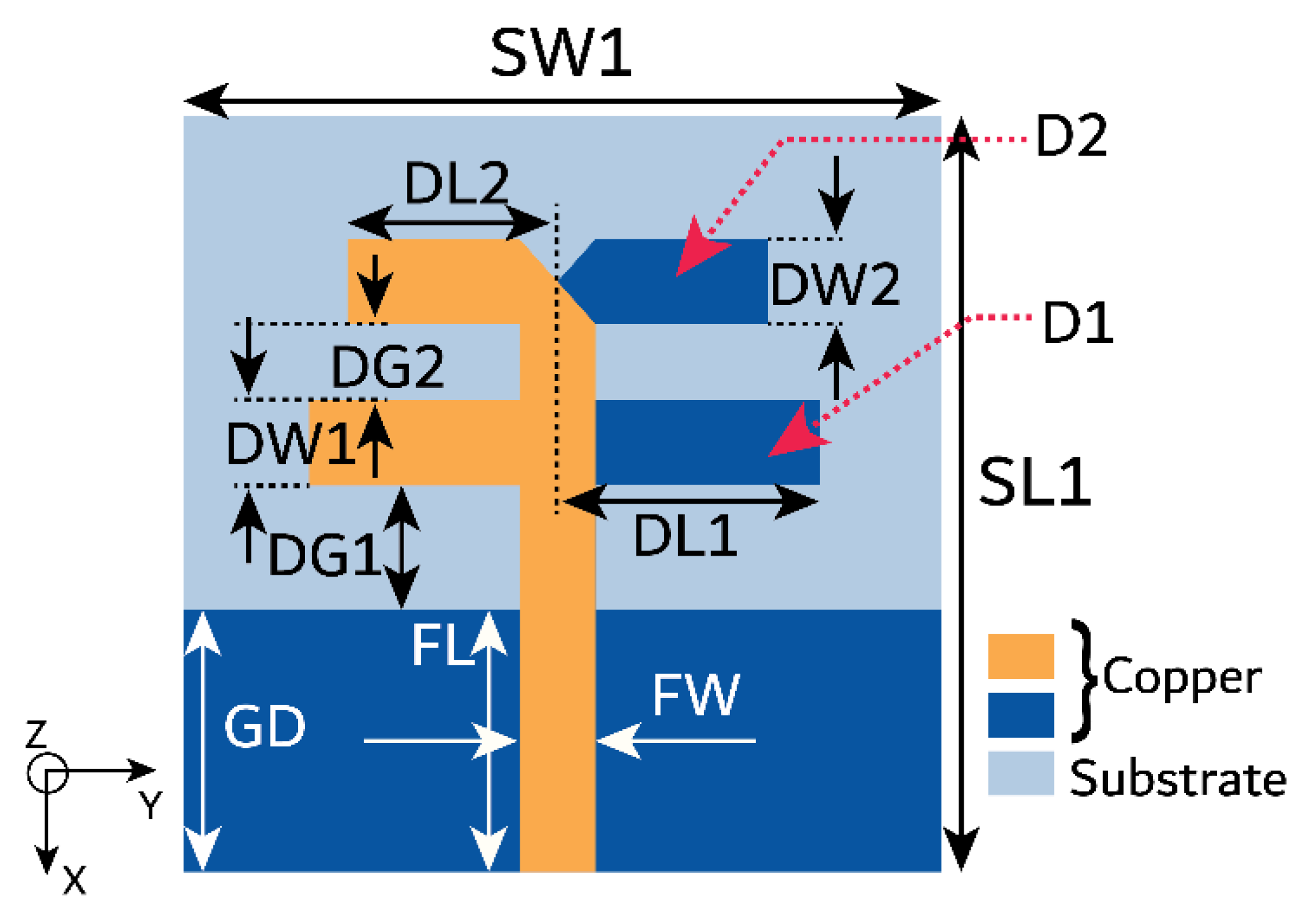
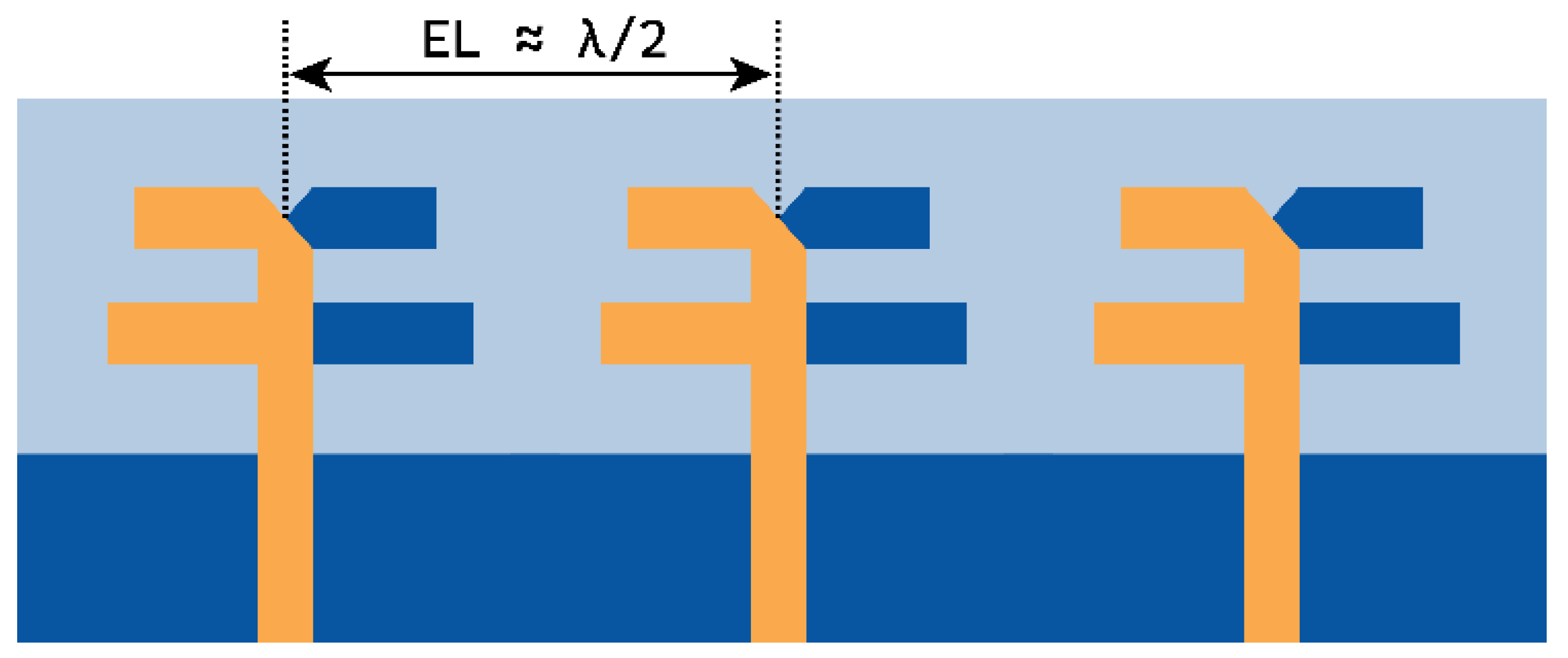

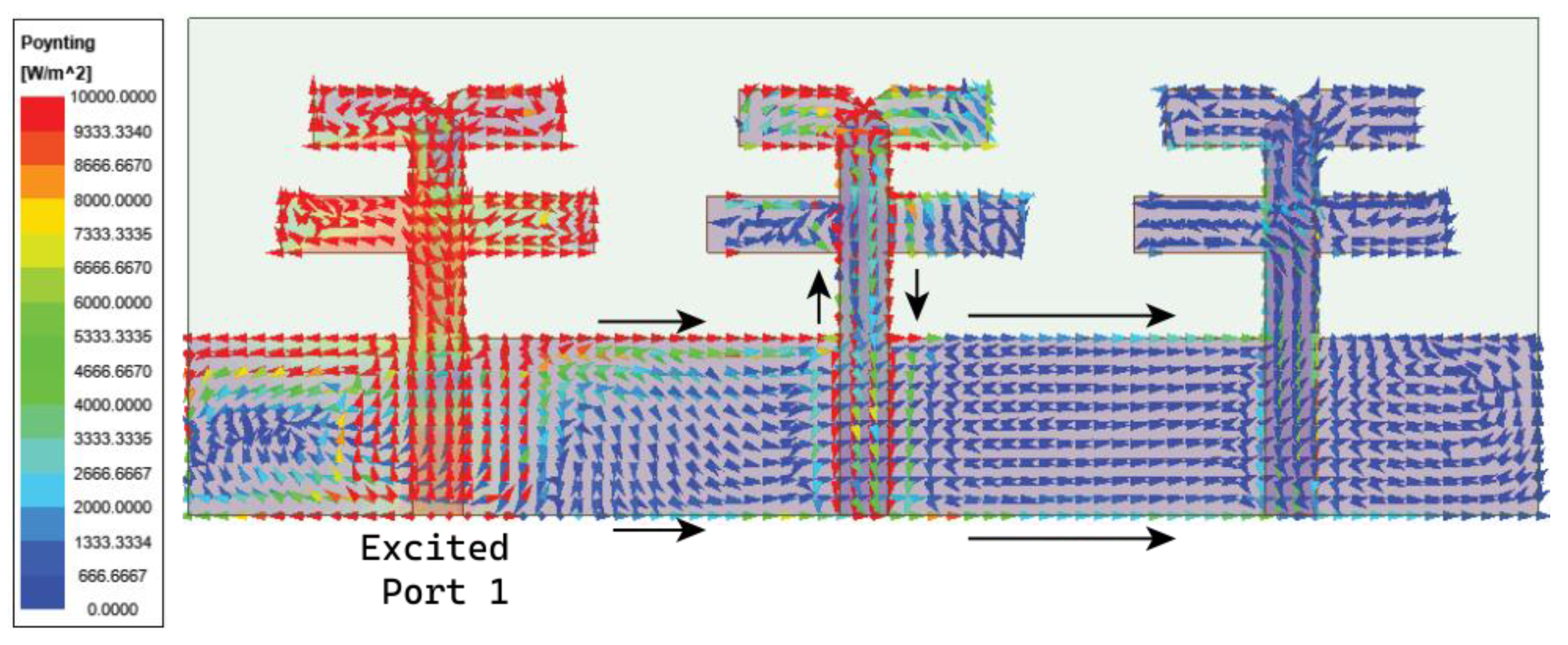
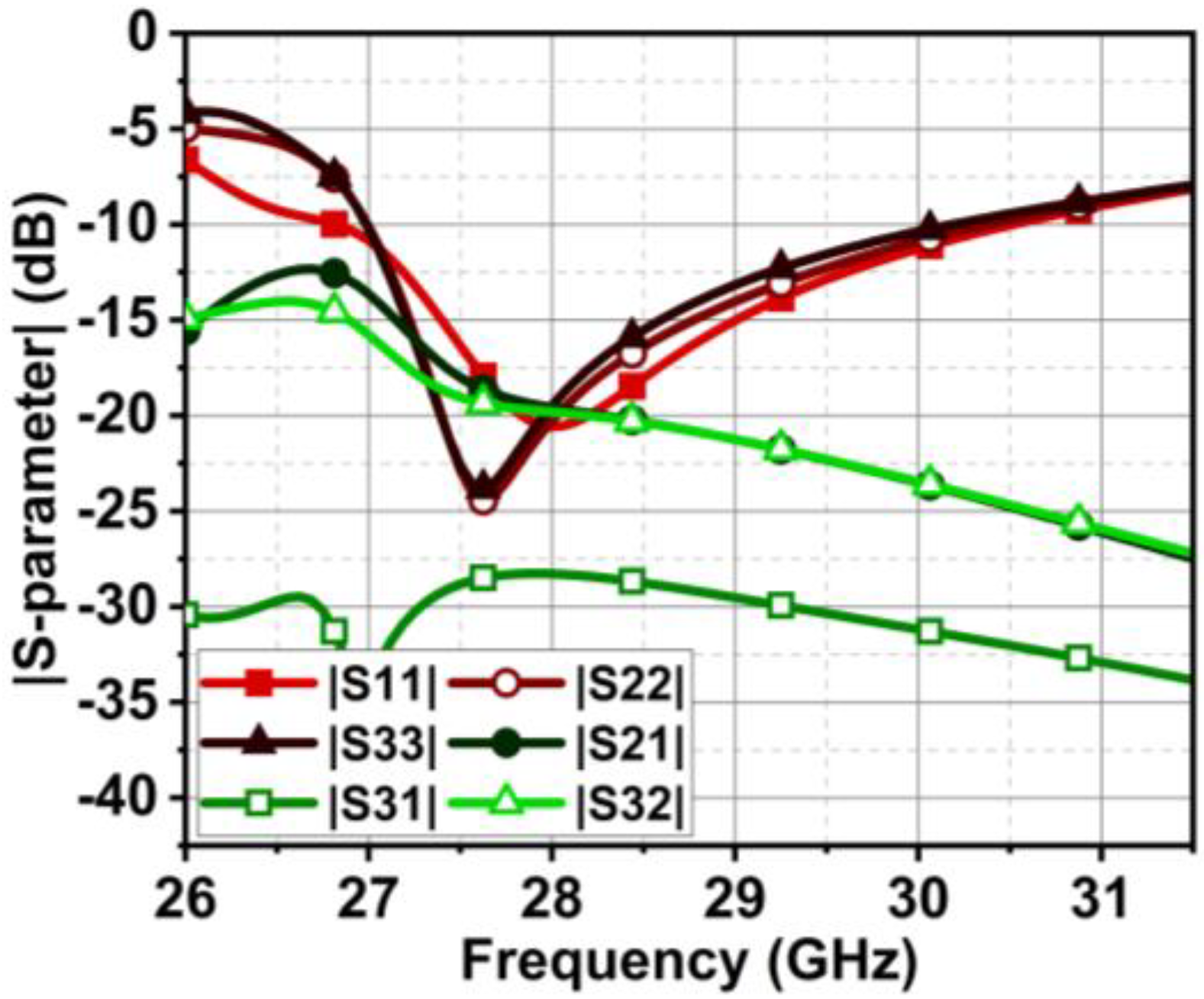
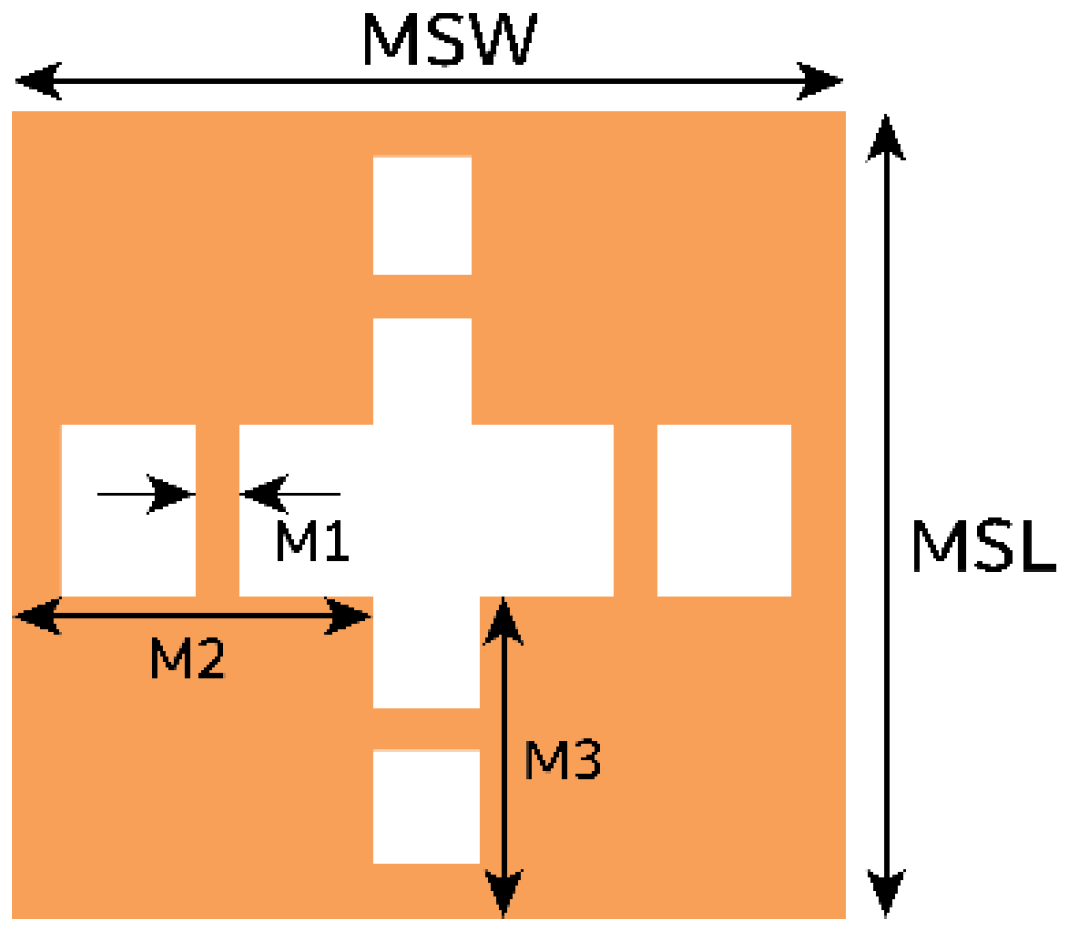
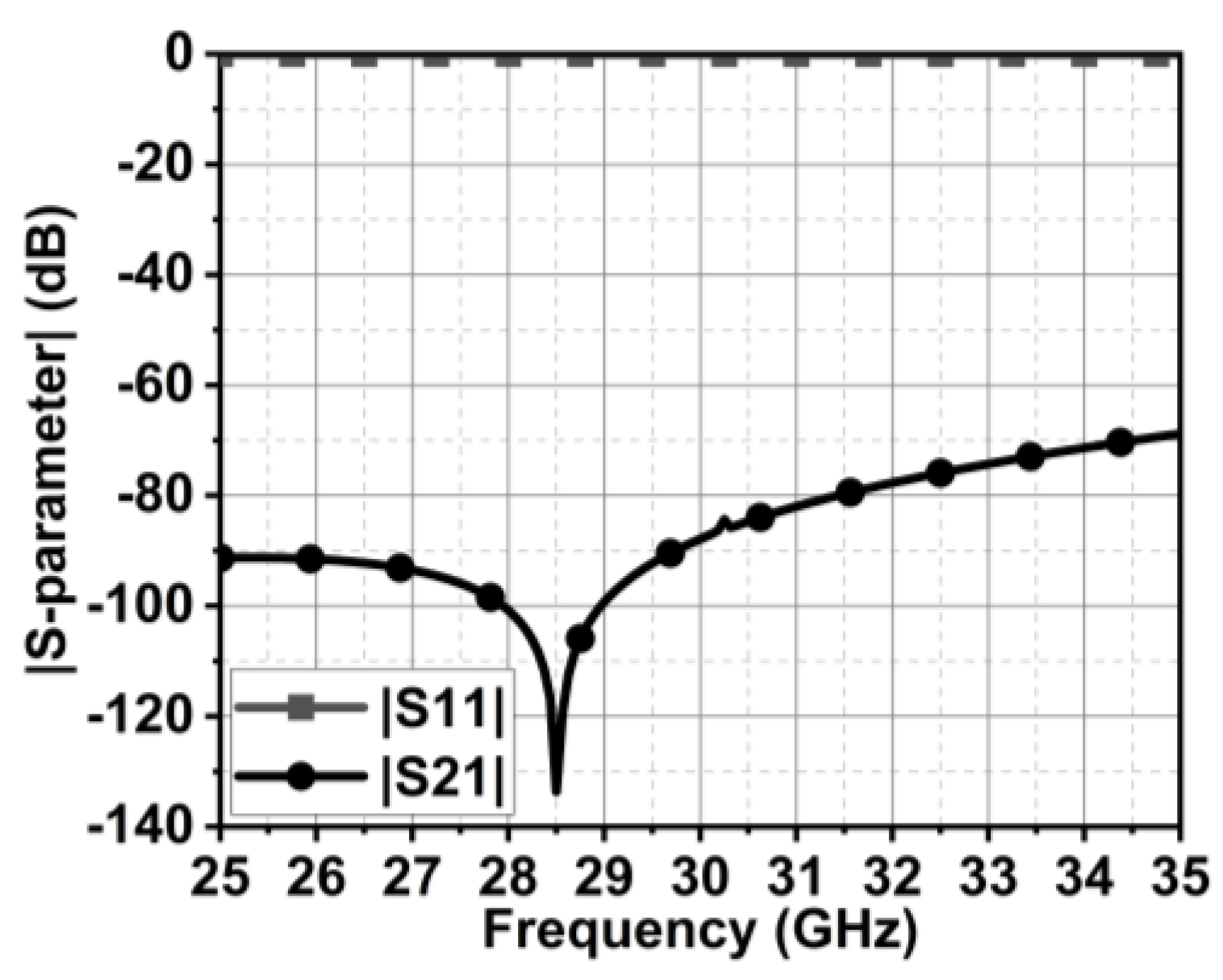
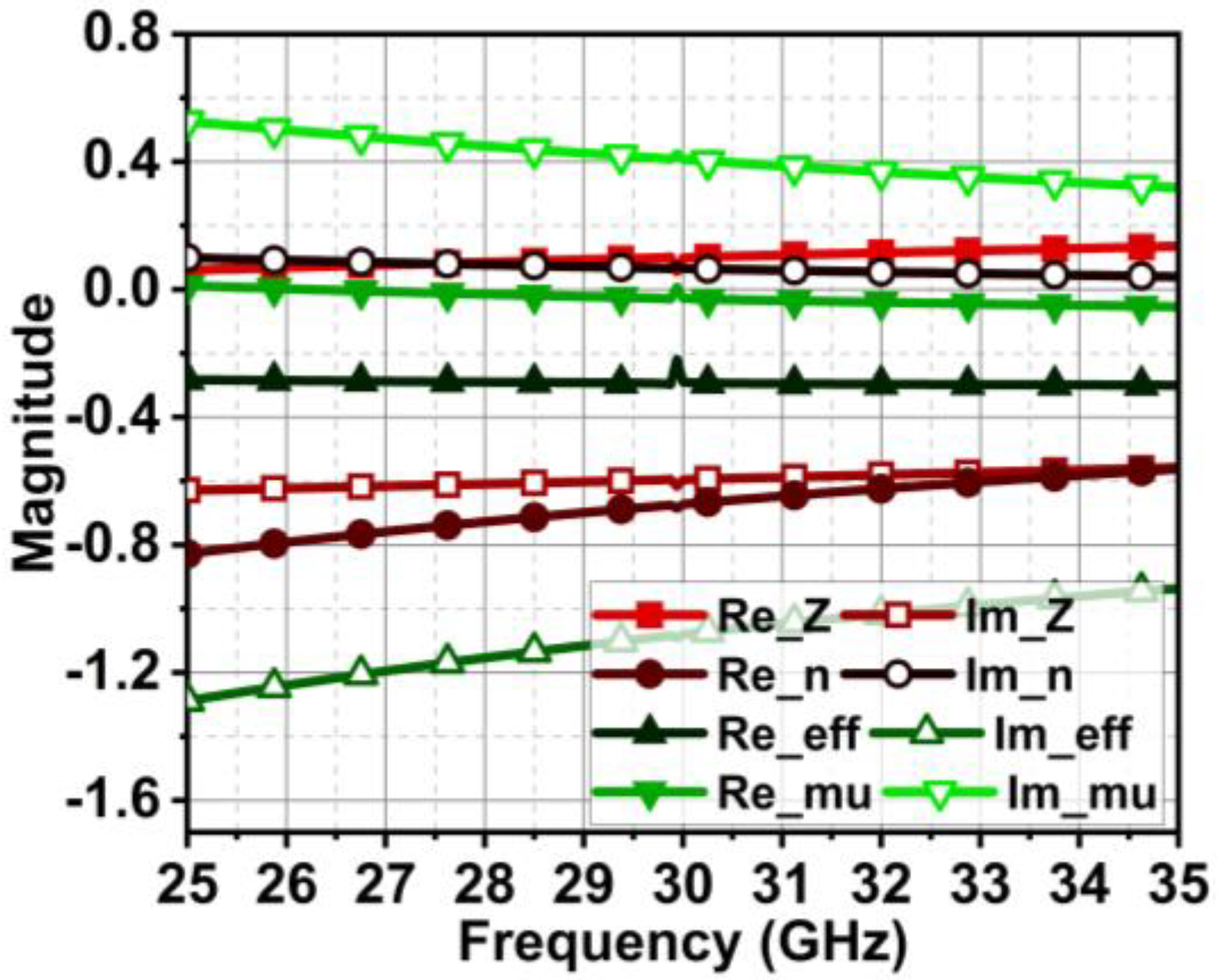
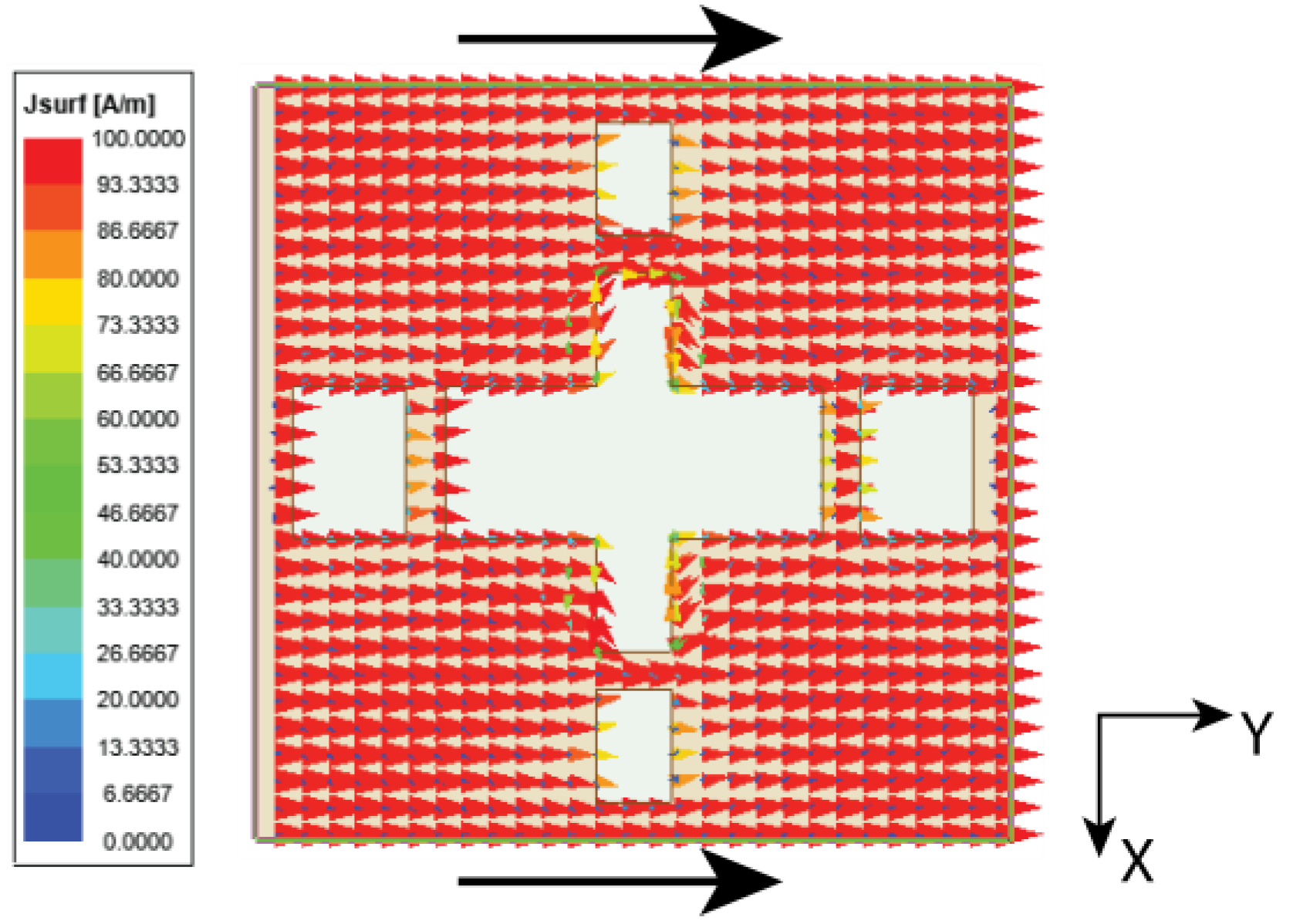

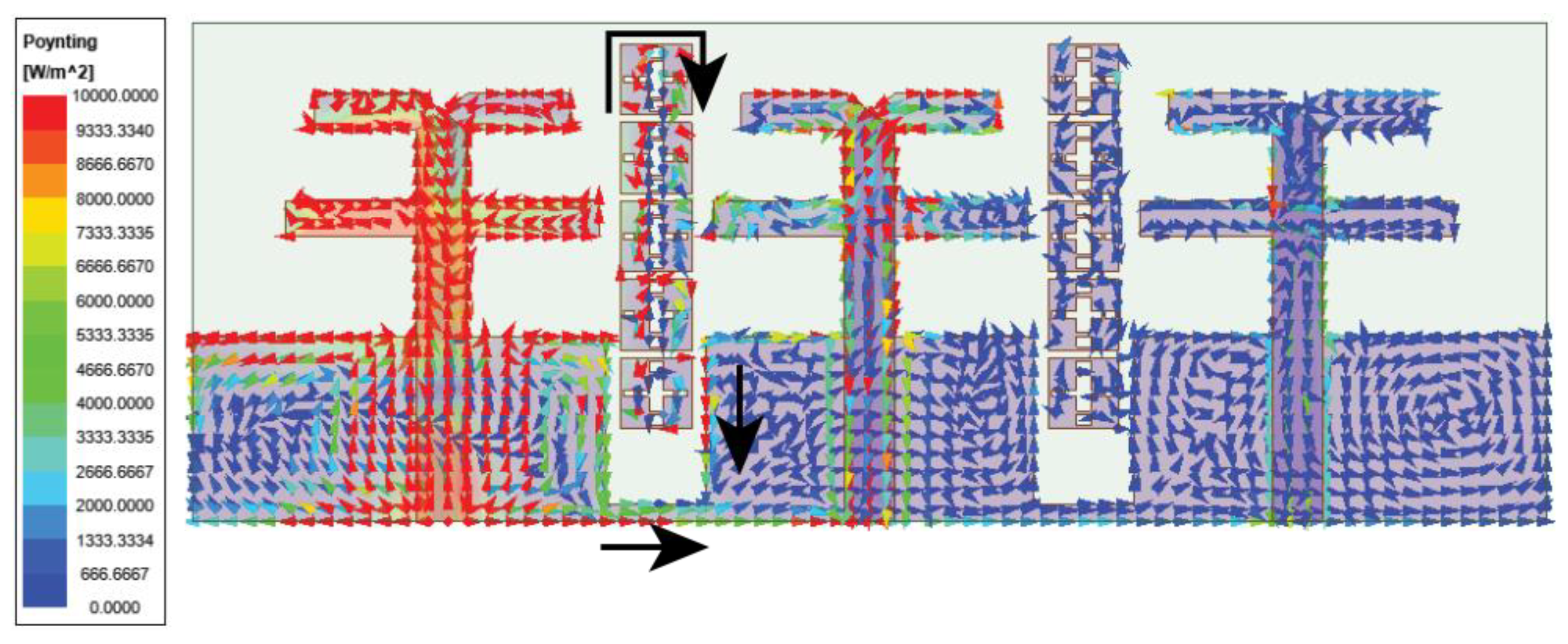
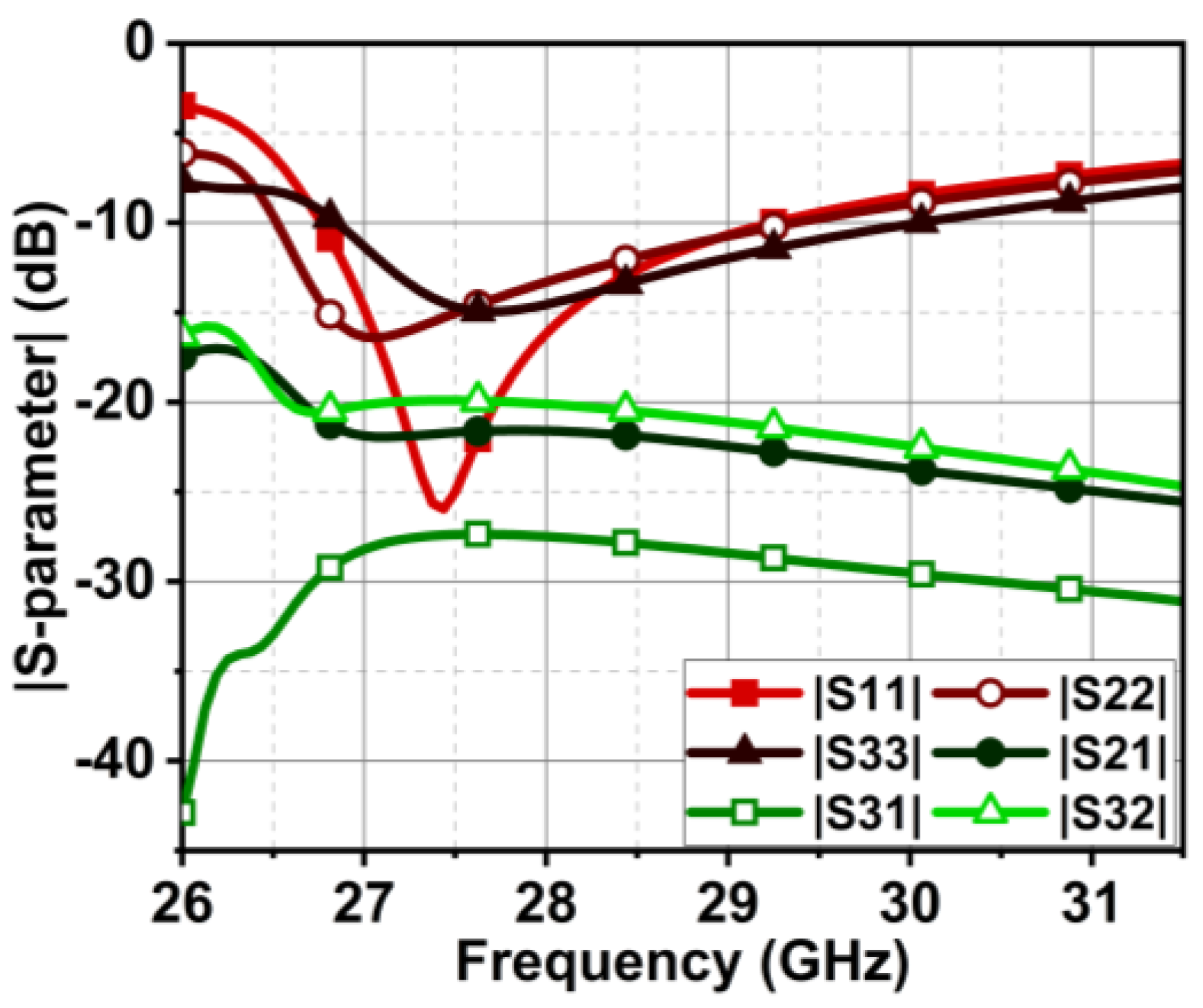


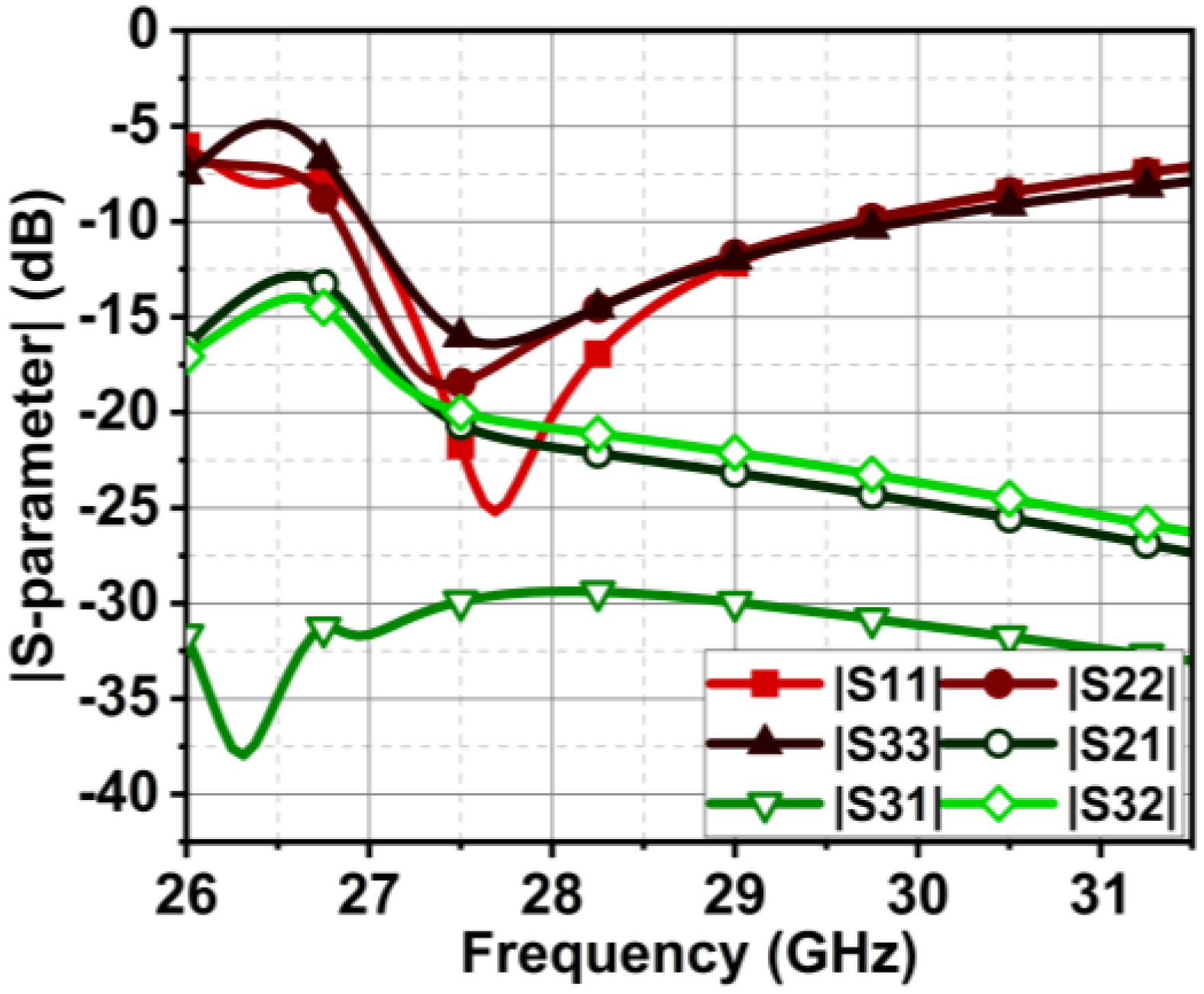

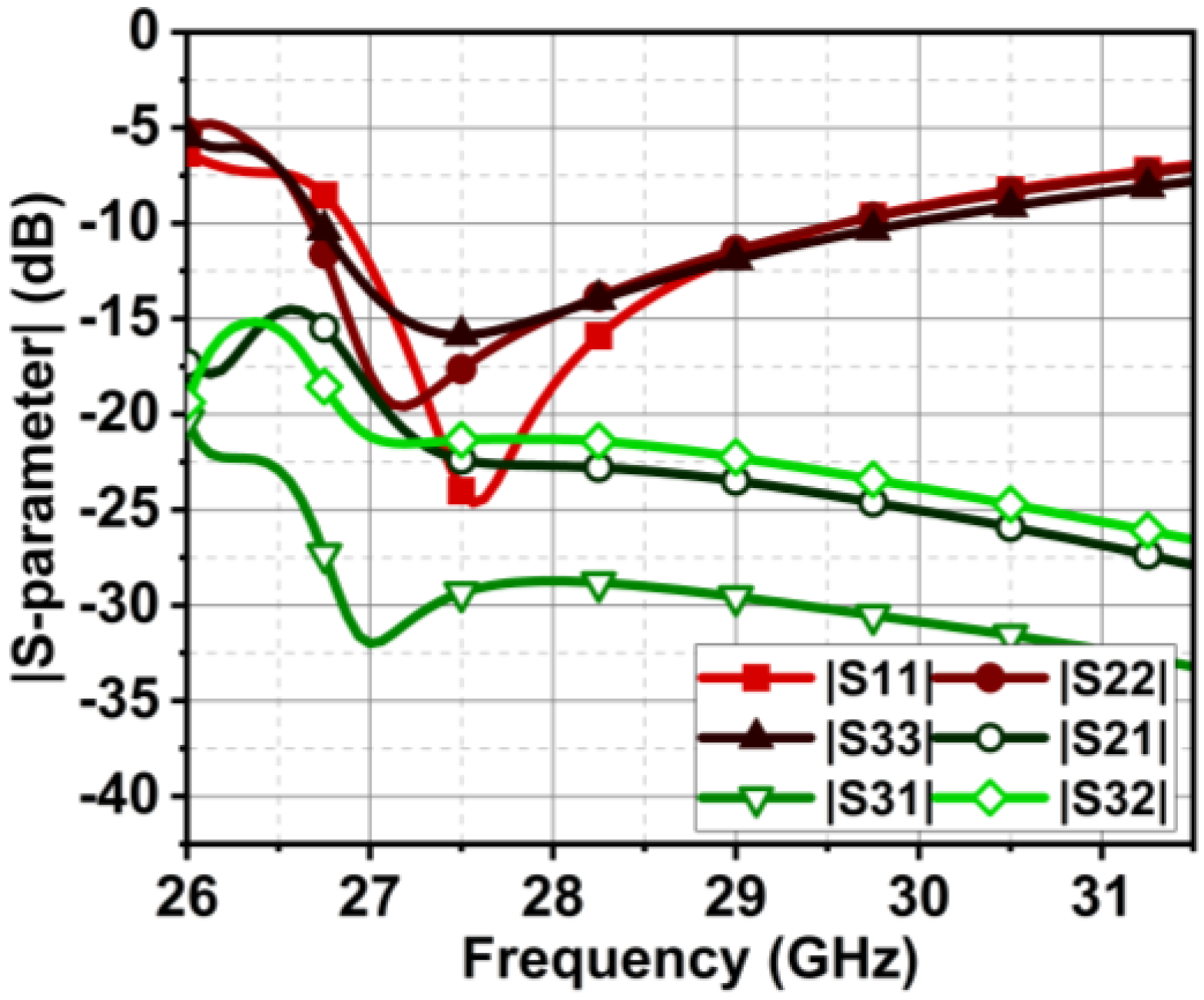
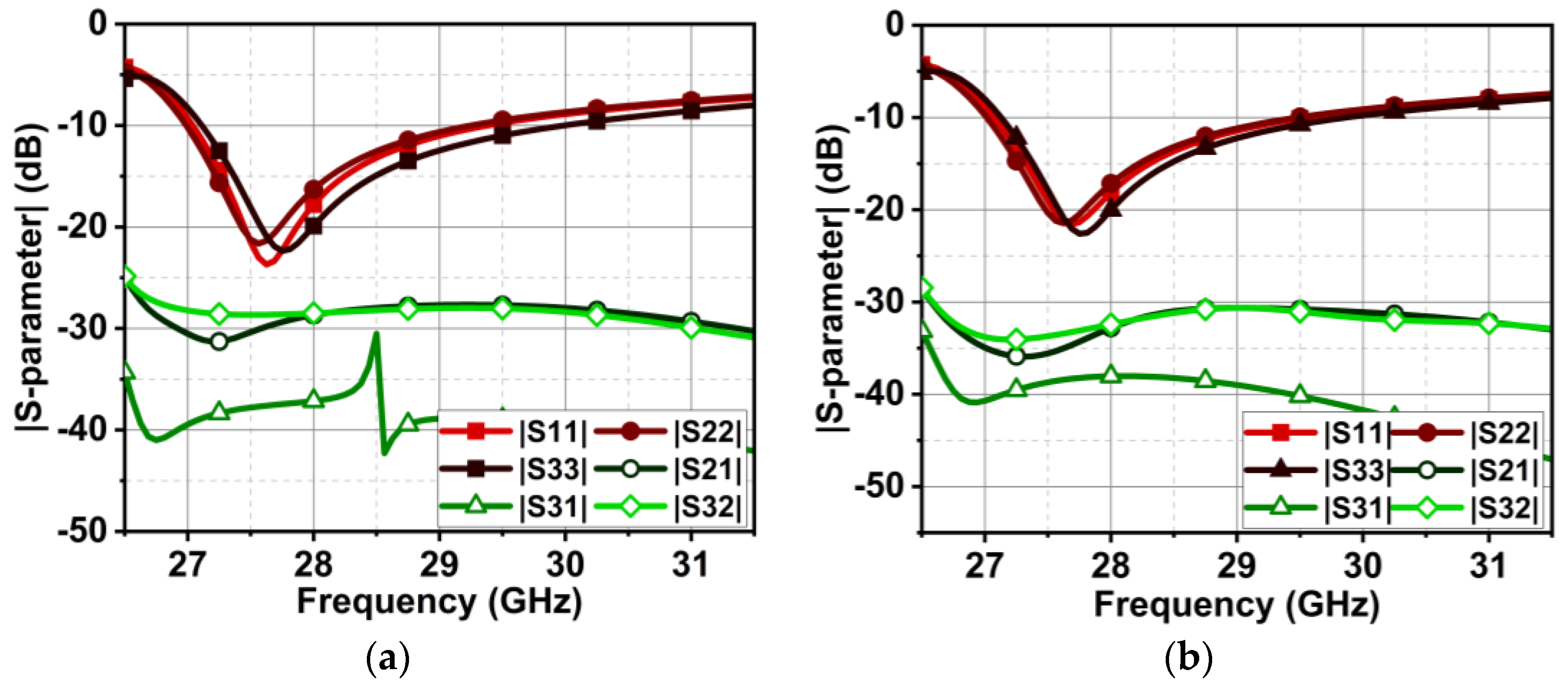

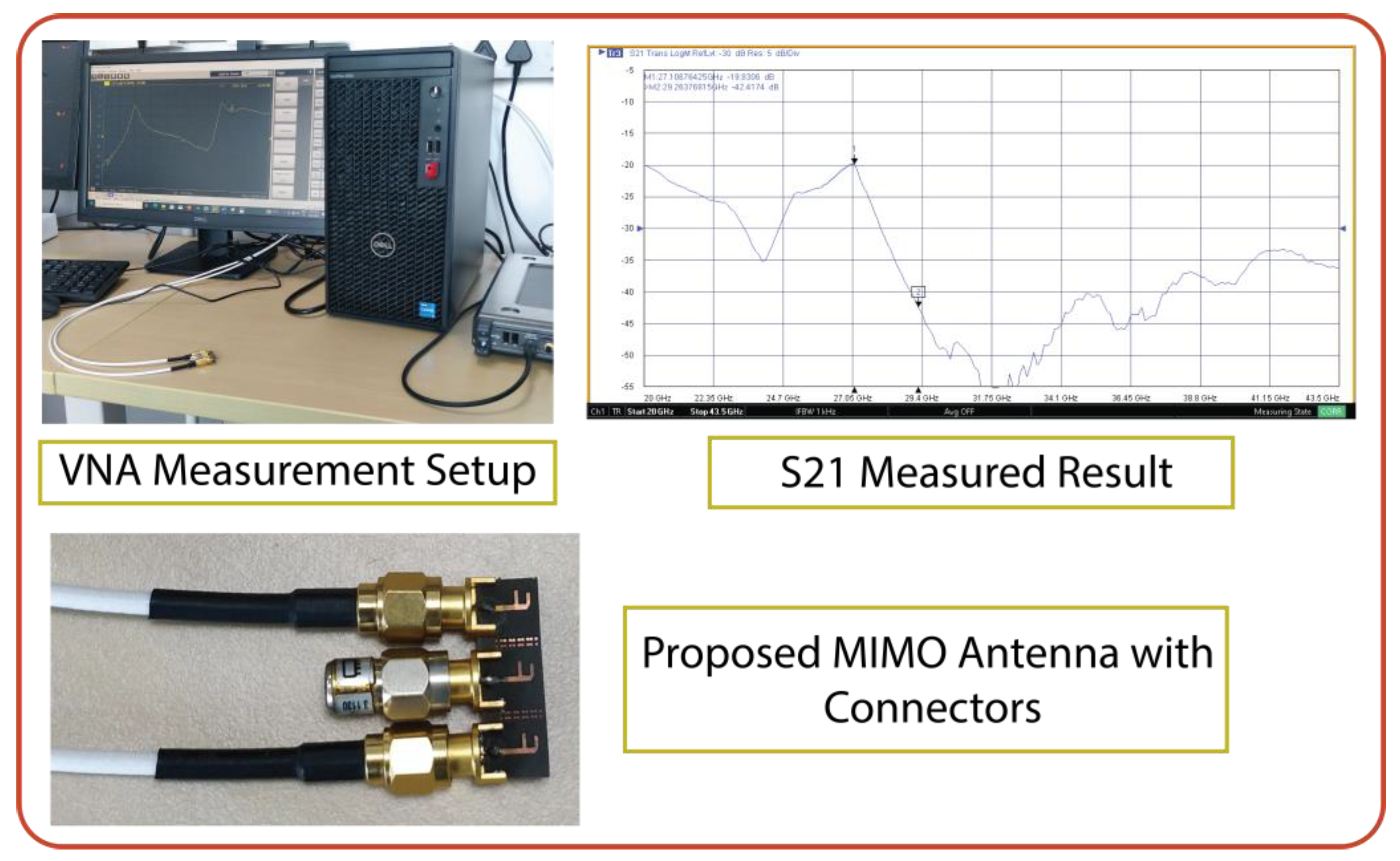
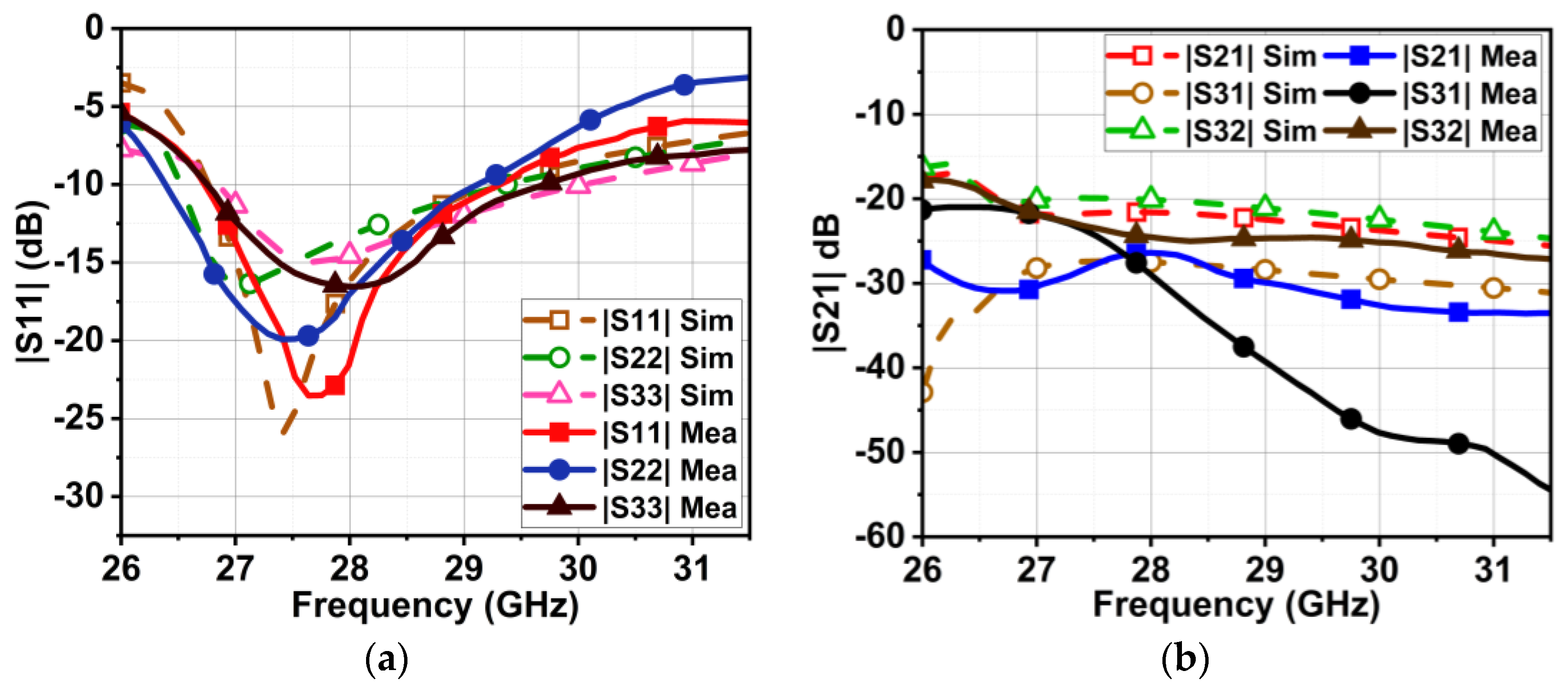
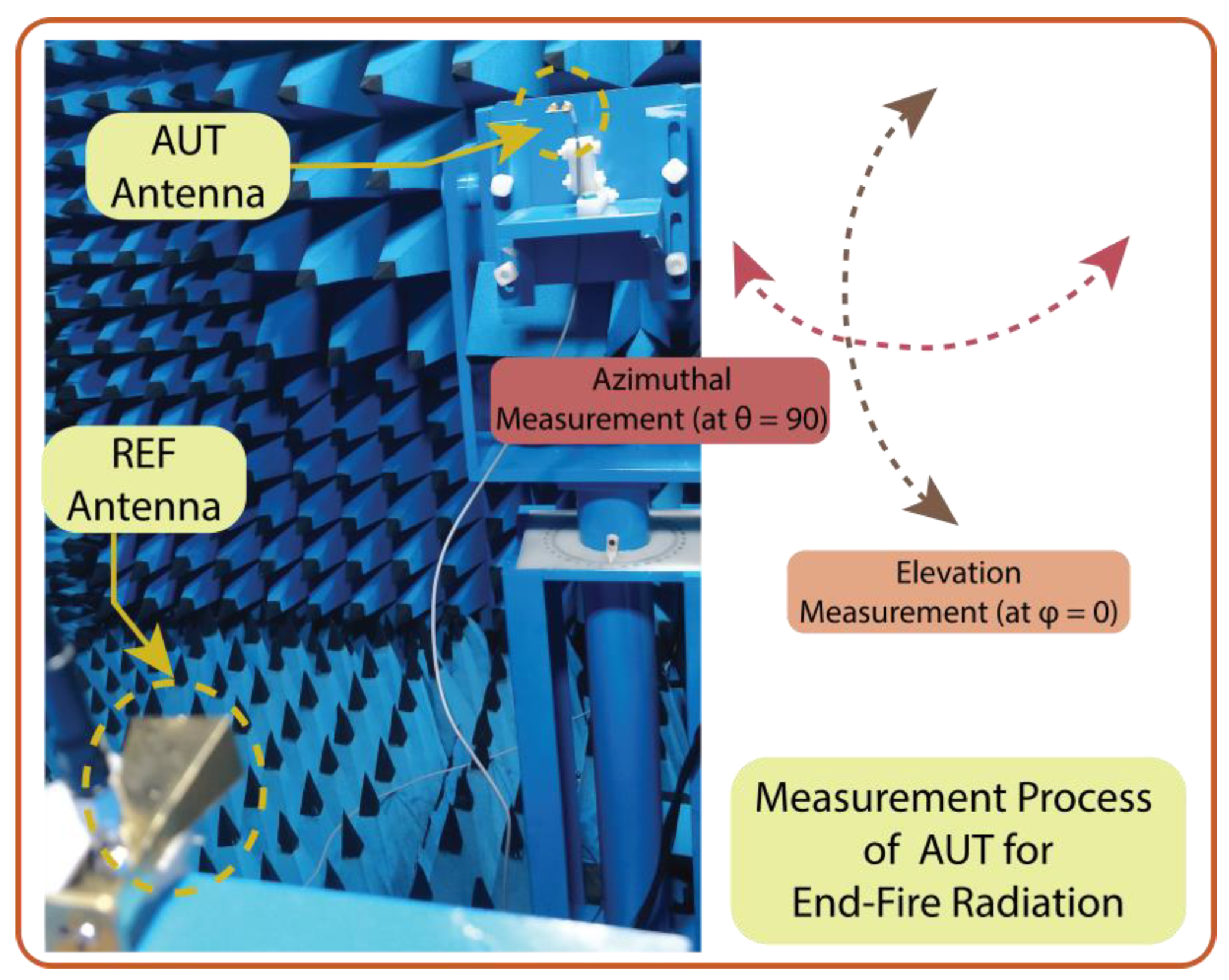

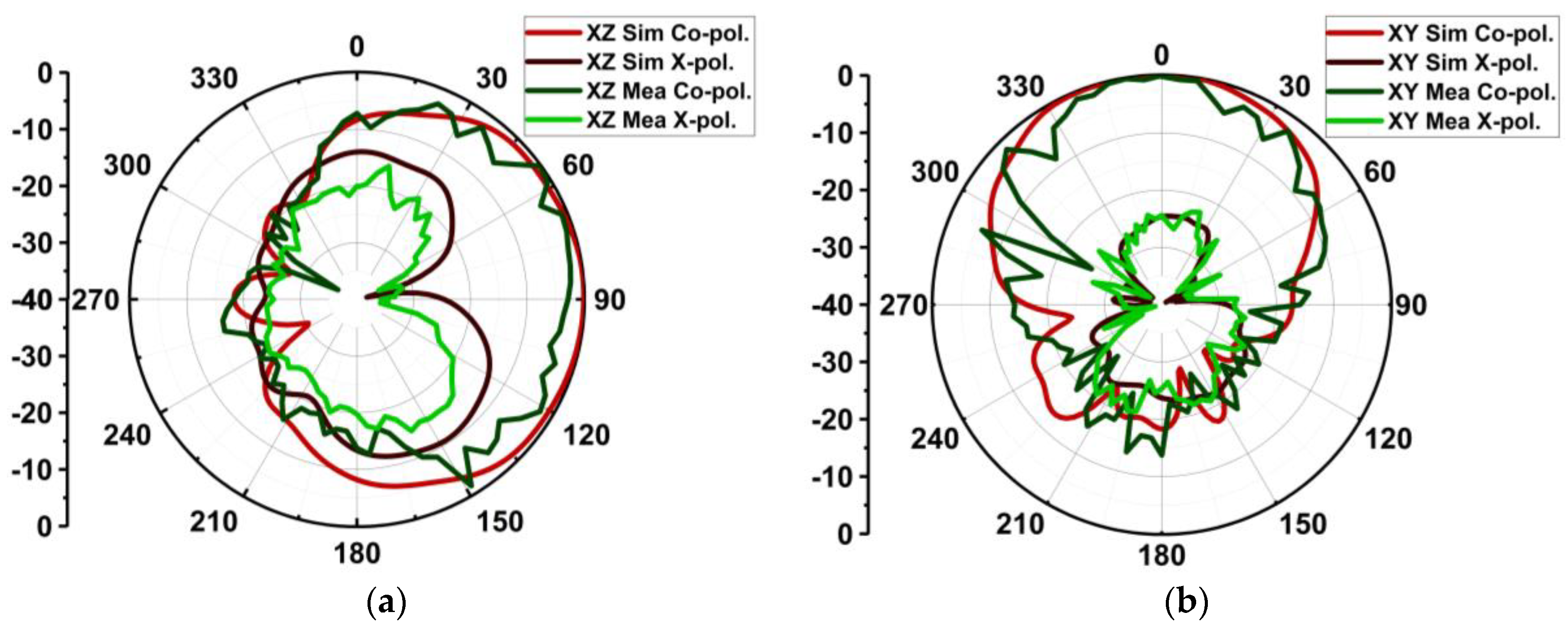
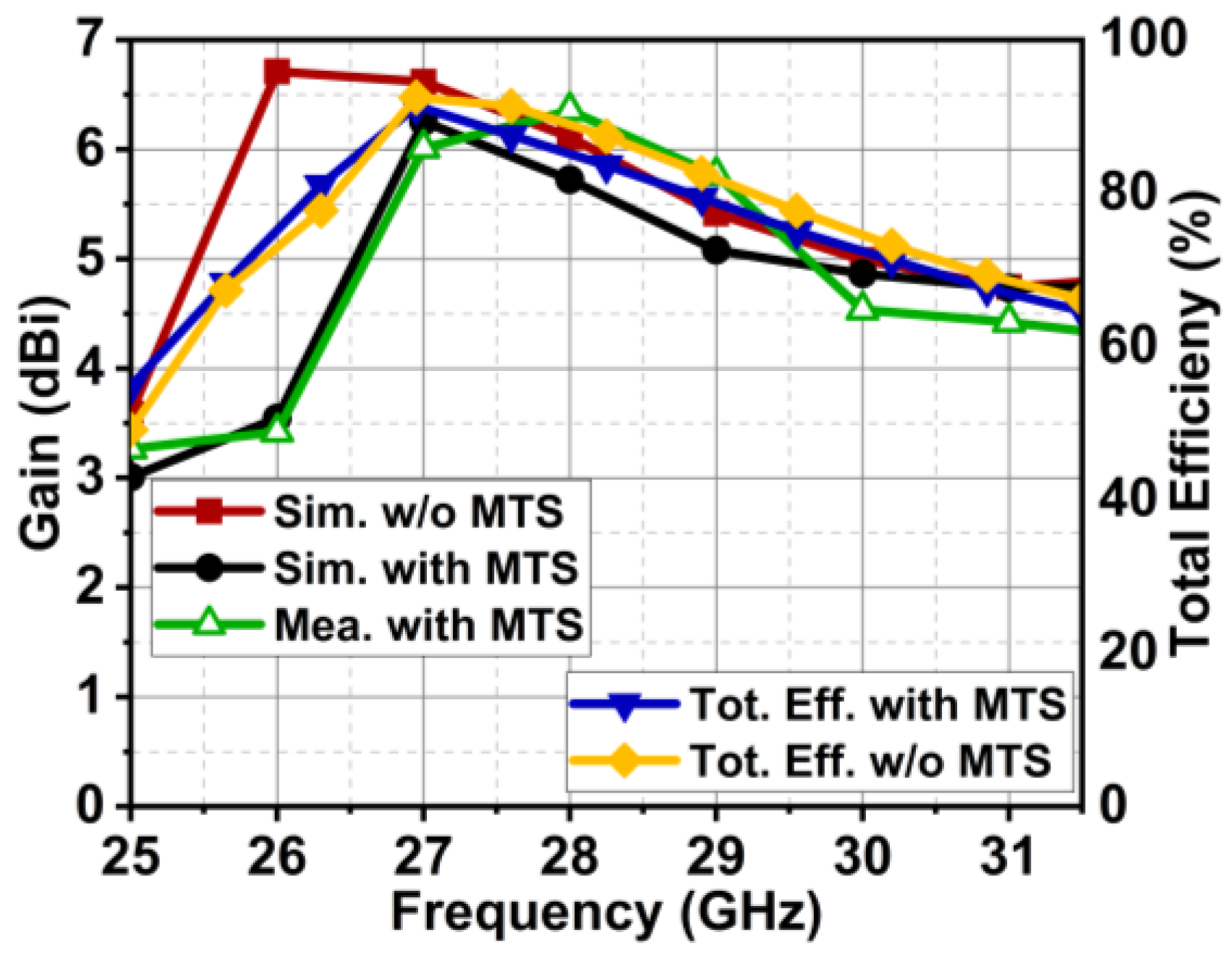
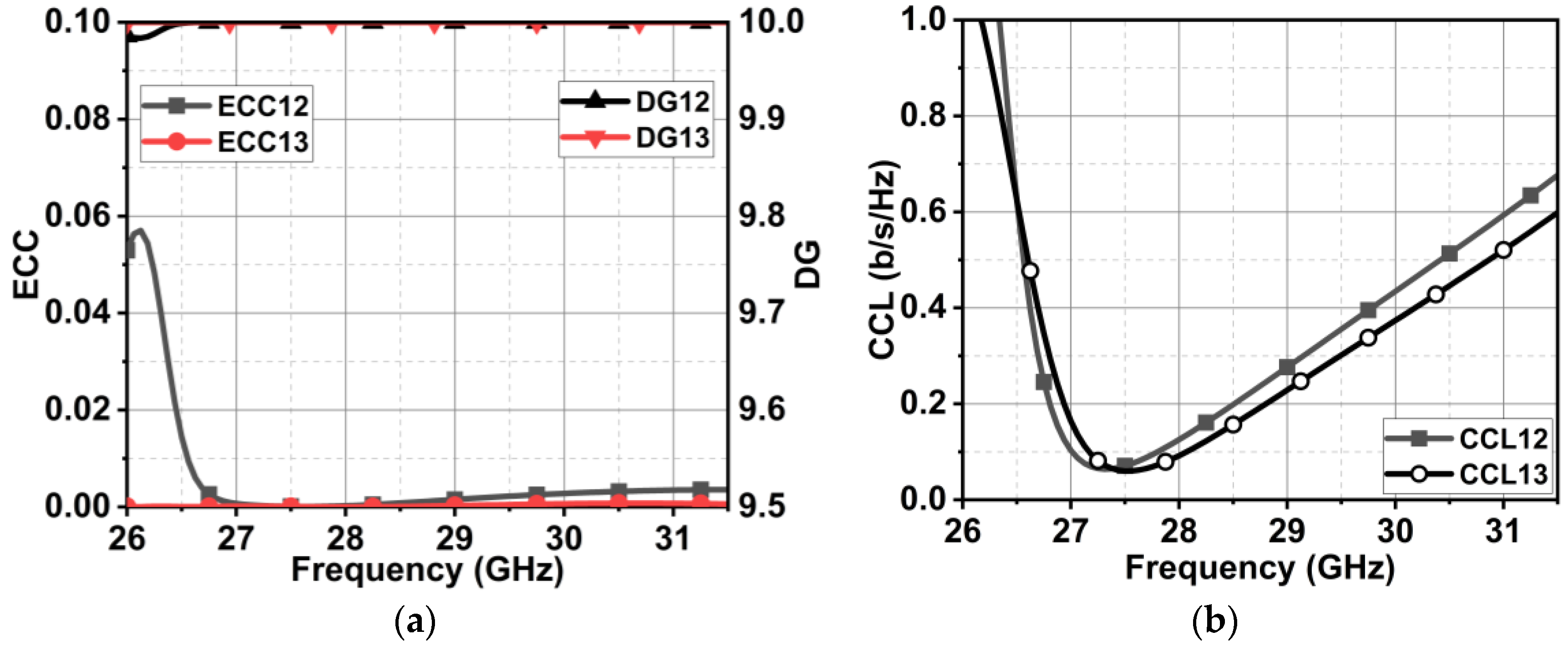
| Ref. | Dim. in λ | Dim. in mm | No. of Ports | Ant. Type | Res. (GHz) | BW (GHz) | Iso. |S211| in dB | Gain (dBi) | MIMO Div. | MIMO GD | ECC | DG | CCL | Rad. |
|---|---|---|---|---|---|---|---|---|---|---|---|---|---|---|
| [31] | 40 | 2-port | Mono. Array | 38 | 37.5–38.5 | >40 | 12 | Pol. | NA | 9.9 | 0.15 | BS | ||
| [37] | 26 | 3-port | Mono. | 28 | 26.5–34 | >25 | NA | Sp. | NA | <0.0015 | 9.9 | 0.025 | BS | |
| [33] | 30 | 4-port | Mono. | 28 | 25–50 | >13 | NA | Pol. | Dis. | >9.99 | 0.21 | NA | ||
| [32] | 30 | 4-port | Mono. Array | 25.5 | 24.5–26.5 | >35 | 7 | Patt. | Con. | <0.0002 | >9.99 | 0.35 | BS | |
| [36] | 48 | 4-port | Mono. | 27.5/40 | 24–33/ 48–42 | >20 | 5.7 | Patt. | Dis. | <0.00015 | >9.99 | NA | Omni. | |
| [34] | 12.5 | 4-port | Mono. | 28 | 26.5–32 | >22 | 3 | Pol. | Con. | <0.27 | >9.98 | 0.25 | Omni. | |
| [38] | 40 | 4-port | SRR | 25/31 | 25–26/ 28–33 | >30 | 7.5 | 3D | Con. | <0.0001 | >9.99 | <1 | EF | |
| [39] | 54 | 8-port | Mono. | 24 | 23.5–27 | >25 | 8.5 | Sp. + Pol. | Con. | <0.005 | >9.99 | NA | BS | |
| [40] | 28 | 2-port | Patch | 27 | 26.5–27/ 39.2–40.5 | >31 | 7 | Sp. | Con. | <0.012 | >9.99 | <0.1 | BS | |
| [35] | 12.4 | 2-port | Patch | 28 | 26.4–31 | >20 | 6.5 | Pol. | Con. | <0.05 | >9.95 | <0.5 | BS | |
| Prop. | 19 | 3-port | DP | 28 | 26.7–29.6 | >21 | 6.3 | Sp. | Con. | <0.04 | >9.99 | <0.3 | EF |
Disclaimer/Publisher’s Note: The statements, opinions and data contained in all publications are solely those of the individual author(s) and contributor(s) and not of MDPI and/or the editor(s). MDPI and/or the editor(s) disclaim responsibility for any injury to people or property resulting from any ideas, methods, instructions or products referred to in the content. |
© 2024 by the authors. Licensee MDPI, Basel, Switzerland. This article is an open access article distributed under the terms and conditions of the Creative Commons Attribution (CC BY) license (https://creativecommons.org/licenses/by/4.0/).
Share and Cite
Ghouse, P.S.B.; John, D.M.; Mane, P.R.; Saha, D.; Balavalikar Shivarama, S.; Pathan, S.; Raghavendra Bhat, B.; Vincent, S.; Ali, T. A Compact MIMO Antenna Based on Modal Analysis for 5G Wireless Applications. Micromachines 2024, 15, 729. https://doi.org/10.3390/mi15060729
Ghouse PSB, John DM, Mane PR, Saha D, Balavalikar Shivarama S, Pathan S, Raghavendra Bhat B, Vincent S, Ali T. A Compact MIMO Antenna Based on Modal Analysis for 5G Wireless Applications. Micromachines. 2024; 15(6):729. https://doi.org/10.3390/mi15060729
Chicago/Turabian StyleGhouse, Parveez Shariff Bhadravathi, Deepthi Mariam John, Pallavi R. Mane, Debdeep Saha, Supreetha Balavalikar Shivarama, Sameena Pathan, Bharathi Raghavendra Bhat, Shweta Vincent, and Tanweer Ali. 2024. "A Compact MIMO Antenna Based on Modal Analysis for 5G Wireless Applications" Micromachines 15, no. 6: 729. https://doi.org/10.3390/mi15060729






